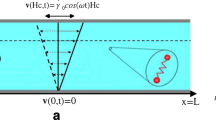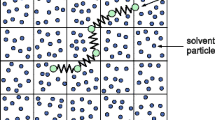Abstract
A versatile model describing the shear thickening behaviour of dilute polymer solutions in high shear flows is presented. The polymer macromolecules are modelled as Hookean elastic dumbbells which deform affinely during flow. In addition, the dumbbells feel a retractive anisotropic hydrodynamic drag and an isotropic Brownian force. Furthermore, it is assumed that high shear rate increases the probability of molecules forming associations and this is described through expressions for the frequencies of association and dissociation, without explicitly accounting for finite extensibility, hydrodynamic interaction or excluded volume effects. Thus, a reversible kinetic process is incorporated into the model, which results in two diffusion equations for the associated and dissociated dumbbells. Numerical simulations predict shear thickening for specific range of parameters, which are physically meaningful and related to molecular characteristics of the polymer. A comparison against experimental data reported in the literature revealed very promising results, thus confirming the ability of this model to predict shear thickening under a wide range of conditions, for various polymer models.
Similar content being viewed by others
Abbreviations
- A :
-
A factor in the frequency of association
- B :
-
Frequency of dissociation
- B 0 :
-
Reference frequency of dissociation
- c :
-
Concentration of polymer solution
- c i :
-
Concentration of singlets (i = 1) and doublets (i = 2) in the solution
- c * :
-
The overlap concentration
- D t :
-
Translation coefficient of molecule
- F i (Q) :
-
Spring force for a singlet (i = 1) and for a doublet (i = 2)
- F :
-
Frequency of association
- F 0 :
-
Reference frequency of association
- H i :
-
Dumbbell spring constant for a singlet (i = 1) and for a doublet (i = 2)
- k :
-
Boltzman's constant
- k H :
-
Huggins constant
- MW :
-
Molecular weight
- MW c :
-
Critical molecular weight for formation of entanglements
- n :
-
Number density of molecules in the polymer solution
- n 0 :
-
Number density of dumbbells at equilibrium
- n i :
-
Number density of singlets (i = 1) and doublets (i = 2)
- Q :
-
Vector defining the size and orientation of a dumbbell
- t :
-
Time
- T :
-
Absolute temperature
- x :
-
Degree of multimerization
- W :
-
Interaction energy between the two components of a doublet
- a :
-
Dimensionless anisotropy parameter
- \(\dot y\) :
-
Shear rate
- ζ i :
-
Friction coefficient of singlets (i = 1) and doublets (i = 2)
- η i :
-
Intrinsic viscosity of singlets (i = 1) and doublets (i = 2)
- η red :
-
Reduced viscosity of solution
- η sp :
-
Specific viscosity
- η :
-
Viscosity of the polymer solution of concentration c
- η s :
-
Viscosity of the solvent
- η(t) :
-
White noise
- K T :
-
Velocity gradient tensor
- λ Hi :
-
Time constant of a singlet (i = 1) and a doublet (i = 2)
- σ1 :
-
Length scale of singlets (standard deviation of singlet lengths at equilibrium)
- σ2 :
-
Length scale of doublets
- T p :
-
Stress tensor
- T xy :
-
Shear Stress (xy element of T p )
- T pi :
-
Contributions to the stress tensor of singlets (i = 1) and doublets (i = 2)
- ψ0 :
-
Equilibrium configuration distribution function of Q
- ψ i :
-
Configuration distribution function of singlets (i = 1) and doublets (i = 2)
References
Ahn KH, Osaki K (1994) A network model for predicting the shear thickening behaviour of a poly(vinyl alcohol)-sodium borate aqueous solution. J Non-Newtonian Fluid Mech 55:215–227
Armstrong RC, Brown RA, Beris AN, Lawler JV, Muller SJ (1985) Evaluation of constitutive equations: material functions and complex flows of viscoelastic fluids. In: Lodge AS, Renardy M, Nobel JA (eds) viscoelastic and rheology. Academic Press, New York
Ballard MJ, Buscall R, Waite FA (1988) The theory of shear-thickening polymer solutions. Polymer 29:1287–1293
Barnes HA (1989) Shear-thickening (“dilatancy”) in suspensions of nonaggregating solid particles dispersed in Newtonain liquids. J Rheol 33:329–366
Bauer WH, Collins EA (1967) Rheology, Vol 4. Academic Press, New York
Biller P, Petruccione F (1988) Rheological properties of polymer dumbbell models with configuration-dependent anisotropic friction. J Chem Phys 89:2412–2418
Bird RB, Curtis CF, Armstrong RC, Hassager O (1987) Dynamics of polymeric liquids, Vol 2: kinetic theory. John Wiley & Sons, New York
Boersma WH, Beats PJM, Laven J, Stein HN (1991) Time-dependent behaviour and wall slip in concentrated shear thickening dispersions. J Rheol 36:1093–1120
Burow S, Peterlin A, Turner DT (1964) Increasing viscosity of polymer solutions with increasing shear stress. Polym Lett 2:67–69
Burow S, Peterlin A, Turner DT (1965) The upturn effect in the non-Newtonian viscosity of polymer solutions. Polym Lett 6:35–41
Dandridge A, Meeten GM, Layec-Raphalen MN, Wolff C (1979) Flow birefringence of dilute solutions of polyethyleneoxide of high molecular weight at high rates. Rheol Acta 18:275–279
De Gennes PG (1979) Scaling concepts in polymers physics. Cornell University Press, Ithaca
Dupuis D, Wolff C (1985) Consequences of a conformational change of flexible macromolecules on the non-Newtonian behaviour of their solutions. Chem Eng Commun 32:203–217
Dupuis D, Wolff C (1993) Shear-thickening behaviour of dilute polymer solutions: kinetic interpretation. J Rheol 37:587–596
Elliasat J, Silberberg A, Katchalsky A (1955) Negative thixotropy of aqueous solutions of polymethacrylic acid. Nature 176:1119–1120
Fan X-J, Bird RB (1985) Configuration-dependent friction coefficients and elastic dumbbell rheology. J Non-Newtonian Fluid Mech 18:255–272
Fixman M (1966) Polymer dynamics: nonnewtonian intrinsic viscosity. J Chem Phys 45:793–803
Flory PJ (1953) Principles of polymer chemistry. Cornell University Press, Ithaca
Freundlich J, Juliusberfer K (1935) Thixotropy influenced by the orientation of anisometric particles in sols and suspensions. J Trans Faraday Soc 31:920–928
Fuller GG (1990) Optical rheometry. Annu Rev Fluid Mech 22:367
Georgelos PN, Torkelson JM (1988a) The role of solution structure in apparent thickening behaviour of dilute PEO/water systems. J Non-Newtonian Fluid Mech 27:191–204
Georgelos PN, Torkelson JM (1988b) Apparent thickening behaviour of dilute polystyrene solutions in extensional flows. Rheol Acta 27:369–383
Giesekus H (1966) Die Elastizität von Flüssigkeiten. Rheol Acta 5:29–35
Gonzalez AE (1983) Viscosity of ionomer gels. Polymer 24:77–80
Graessley WW, Edwards SF (1981) Entanglement interactions in polymers and the chain contour concentration. Polymer 22:1329–1334
Greiner A, Strittmatter W, Honerkamp J (1988) Numerical integration of stochastic differential equations. J Stat Phys 31:95–108
Hess O, Hess S (1994) Nonlinear fluid behaviour: from shear thinning to shear thickening. Physica A 207:517–540
Hu Y, Wang SQ, Jamieson AM (1993) Rheological and flow birefringence studies of a shear thickening complex fluid-A surfactant model system. J Rheol 37:531–546
Inoue T, Osaki K (1993) Rheological properties of poly(vinyl alcohol)/sodium borate aqueous solutions. Rheol Acta 32:550–555
James DF, McLaren DR (1975) The laminar flow of dilute polymer solutions through porous media. J Fluid Mech 70:733–752
Joly M (1965) Aggregation proroquee par l'ecoulement dans les solutions de macromolecules d'origine biologique. Biorheology edited by A. Copley, pp. 45–68. Interscience, New York
Keller DS, Keller DV (1990) An investigation of the shear thickening and antithixotropic behaviour of concentrated coal-water dispersions. J Rheol 34:1267–1291
Keller DS, Keller DV (1991) The effect of particle size distribution on the antithixotropic and shear thickening properties of coal-water dispersions. J Rheol 35:1583–1607
Ketz RJ, Graessley WW, Prud'homme RK (1991) Polymer prepr. American Chemical Soc, Div Polym Chem 32:613
Kishbaugh AJ, McHugh AJ (1993) A rheooptical study of shear-thickening and structure formation in polymer solutions Part 1. Experimental. Rheol Acta 32:9–24
Larson RG (1988) Constitutive equations for polymer melts and solutions. Butterworths, Boston
Layec-Raphalen MN, Wolff C (1976) On the shear-thickening behaviour of dilute solutions of chain macromolecules. J Non-Newtonian Fluid Mech 1:159–173
Leibler L, Rubinstein M, Colby RH (1991) Dynamics of reversible networks. Macromolecules 24:4701–4707
Magda JJ, Larson RG, Mackay ME (1988) Deformation-dependent hydrodynamic interaction in flows of dilute polymer solutions. J Chem Phys 89:2504–2513
Manley RStJ, Mason SG (1952) Particle motions in sheared suspensions. II. Collisions of uniform spheres. J Colloid Sci 7:354–369
Marrucci G, Bhargava S, Cooper SL (1993) Models of shear-thickening behaviour in physically cross-linked networks. Macromolecules 26:6483–6488
Öttinger HC (1987) Generalized Zimm model for dilute polymer solutions under theta conditions. J Chem Phys 86:3731–3749
Peterlin A (1960) Gradient dependence of intrinsic viscosity of freely flexible linear macromolecules. J Chem Phys 33:1799–1803
Peterlin A (1963) Mean dimensions of macromolecular coil in laminar flow. J Chem Phys 39:224–229
Peterlin A, Turner DT (1963) Rheopexy in dilute polymer solutions at low shear gradients. Nature 197:488–489
Petruccione F, Biller P (1988a) Rheological properties of network models with configuration-dependent creation and loss rates. Rheol Acta 27:557–561
Petruccione F, Biller P (1988b) A numerical stochastic approach to network theories of polymeric fluids. J Chem Phys 89:577–582
Rudisill JW, and Cummings PT (1992) Brownian dynamics simulation of model polymer fluids in shear flow. I. Dumbbell models. J Non-Newtonian Fluid Mech 41:275–288
Savings JG (1968) Shear-thickening phenomena in poly(vinyl alcohol)/borate complexes. Rheol Acta 7:87–92
Selby TW, Hunstad HA (1962) ASTM Pub No 299, 98
Shenoy AV (1984) A review on drag reduction with special reference to micellar systems. Colloid Polym Sci 262:319–337
Quadrat O, Bohdanecky M, Munk P (1967) Influence of thermodynamic quality of a solvent upon non-Newtonian viscosity of poly(methyl methacrylate) solutions. J Polym Sci C 16:95–101
van den Brule BHAA (1993) Brownian dynamics simulation of finitely extensible bead-spring chains. J Non-Newtonian Fluid Mech 47:357–378
Vlassopoulos D, Schowalter WR (1993) Characterization of the non-Newtonian flow behaviour of drag-reducing fluids. J Non-Newtonian Fluid Mech 49:205
Vrahopoulou EP, McHugh AJ (1987a) Shear-thickening and structure formation in polymer solutions. J Non-Newtonian Fluid Mech 25:157–175
Vrahopoulou EP, McHugh AJ (1987b) Shear-induced association of polymer molecules. Chem Eng Comm 57:289–295
Witten Jr TA, Cohen MH (1985) Cross-linking in shear-thickening ionomers. Macromolecules 18:1915–1918
Wolff C (1962) Etude del la viscosity nonNewtonienne de deux polystyrenes dans en solvant tres visqueu. J Chim Phys 59:413
Wolff C (1982) Non-newtonian behaviour of associations of macromolecules in dilute solutions. Adv Colloid and Interface Sci 17:263–274
Wolff C, Silberberg A, Priel Z, Layec-Raphale MN (1979) Influence of the association of macromolecules in dilute solution on their reduced viscosity. Polymer 20:281–287
Zylka W, Ottinger HC (1989) A comparison between simulations and various approximations for Hookean dumbbells with hydrodynamic interaction. J Chem Phys 90:474–480
Zylka W (1991) Gaussian approximation and Brownian dynamics simulation for Rouse chains with hydrodynamic interaction undergoing simple shear flow. J Chem Phys 94:4628–4636
Author information
Authors and Affiliations
Rights and permissions
About this article
Cite this article
Hatzikiriakos, S.G., Vlassopoulos, D. Brownian dynamics simulations of shear-thickening in dilute polymer solutions. Rheola Acta 35, 274–287 (1996). https://doi.org/10.1007/BF00366914
Received:
Accepted:
Issue Date:
DOI: https://doi.org/10.1007/BF00366914




